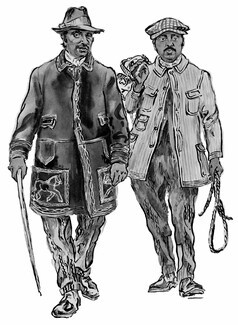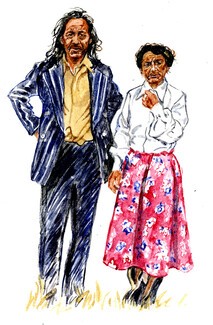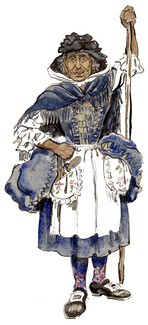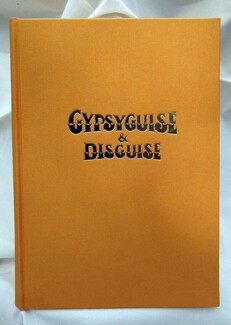‘Proud as a Peacock’ – illustrated book shows Gypsy clothes through the ages
Gypsyguise and Disguise: a History of Gypsy Fashion by Juliet Jeffery
Hardback, illustrated, 'The book is dedicated to the memory of Rhona and Will Taylor and is a limited edition of 100 copies'
A review by Damian Le Bas

‘Gypsy’. The word has been used to sell everything from high fashion collections to high street summer skirts, but the implication is always the same: buy this and you’ll stand out.
This association of ethnic Gypsy life with unique styles of dress is centuries old. Laws passed during the reign of Henry VIII mention “outlandish people calling themselves Egyptians”, and other evidence from the time suggests that Gypsies could be spotted a mile off because they didn’t dress like anybody else. So modern TV programmes that focus on brash Traveller styles aren’t really saying anything new. The clothes themselves might change, but the desire to not look like the outsiders – the gadje, gorjers, buffers or country people – might have always been there, in one form or another. As it still is.

Juliet Jeffery, on the other hand, has definitely done something new: produced a fully illustrated book that focuses on the history and evolution of Gypsy fashions. Make no mistake, this book is a one-off. It’s a comprehensive look at Romany and Traveller dress down the centuries, up to the present day. It journeys from the earliest references to Gypsy attire in Mediaeval paintings and manuscripts, right up to the flash and brash 'race-day' outfits on show at twenty-first century horse fairs. Lavishly illustrated with hundreds of the author’s paintings, this book will be a revelation for those unfamiliar with Gypsy history, and full of surprises and new information for those who already know their stuff. It feels a bit ridiculous trying to do justice to this book with words alone. Like a sunny Saturday when Appleby Fair is in full swing, you really need to see it to believe it.

Her focus is on clothes, but by describing them in such depth, Jeffery sheds light on other aspects of Gypsy culture. "The Gypsies brought from India three characteristics," she writes in the second chapter: "a conservatism or traditionalism, a love of jewellery and a partiality to bright colour." More specifically, they brought four particular items of clothing: "the women's scarf, the diklo (neckerchief) worn by men, the blanket for both sexes and the women's intricate plaited hairstyles and preference for long hair.” As she also points out, it is the traditionalism - Gypsy people's tenacity in retaining old habits - that has kept so many of the other customs going. Much has changed down the centuries, with the result that today there is no such thing as simply "Gypsy dress"; and yet some of these items and tendencies have survived to a remarkable degree.
The book begins long ago, before the first large-scale arrival of Romany people in Britain (we should remember that at least one person of Romany heritage lived in East Anglia in the 11th century AD, and that non-Romany nomadic people were already living across the isles long before that). There are various early 15th century references to dark-skinned bushy-bearded men arriving in various parts of continental Europe, and they attracted various names: Tartars, "penancors", strangers. Some wore two rings in each ear; others went about in "shifts tied on the shoulder with linen cords, and unusual short cloaks". A story of their being "Dukes of Lower Egypt" soon caught on. “Strange attire and garments" soon began to be seen as part and parcel of who the Gypsies were. This, combined with rumours that they had switched back and forth between Islam and Christianity in order to avoid perspecution in different places, helped to generate an air of mystery and untrustworthiness.
Moving with a keen eye through rich historical evidence, Jeffery refers to French tapestries, Bohemian engravings and Victorian travelogues, gleaning for any and all references to what the Gypsies wore. We learn about various luxurious materials and items of the past: toga-like wrapping blankets, Italian silks, oriental cloths, and head-dresses including gold-embroidered bonnets and turbans, some with delicate veils attached. Jeffery also explains some of the changing customs around dressing for weddings, christenings and funerals. In the 19th century, deep red was sometimes used as a colour of mourning. There are even accounts of Gypsy women going to funerals wearing long red cloaks bought specifically for the occasion.
Moving forward through time, there are whole sections on gold jewellery – brooches, sovereigns and creole earrings – and kushti chokkers, especially the handmade dealer boots and Northampton brogues beloved of travelling men. She mentions the tailor in Oxfordshire who drew the business of Romany men from hundreds of miles around, all in search of a custom suit so that not even a ‘proper old rai mush’ could say he had the same.

Moving with a keen eye through rich historical evidence, Jeffery refers to French tapestries, Bohemian engravings and Victorian travelogues, gleaning for any and all references to what the Gypsies wore. We learn about various luxurious materials and items of the past: toga-like wrapping blankets, Italian silks, oriental cloths, and head-dresses including gold-embroidered bonnets and turbans, some with delicate veils attached. Jeffery also explains some of the changing customs around dressing for weddings, christenings and funerals. In the 19th century, deep red was sometimes used as a colour of mourning. There are even accounts of Gypsy women going to funerals wearing long red cloaks bought specifically for the occasion.
Moving forward through time, there are whole sections on gold jewellery – brooches, sovereigns and creole earrings – and kushti chokkers, especially the handmade dealer boots and Northampton brogues beloved of travelling men. She mentions the tailor in Oxfordshire who drew the business of Romany men from hundreds of miles around, all in search of a custom suit so that not even a ‘proper old rai mush’ could say he had the same.
Another extraordinary sight awaits us at the end of the book: dozens of pages of paintings, showing the changing fashions on display at the fairs from the mid-1980s up until recent years. It was a trip down memory lane for me and I’m grateful for the ride.
Copies of this beautiful limited edition book are available directly from the author Juliet Jefferey.
Cost of the book is £95 plus £15 post & packing PO Special Delivery or buyer collect
Cheques payable to Juliet Jeffery, The Providence, 23A Mill Street, Ludlow, Shropshire SY8 1BG tel. 01584 874481